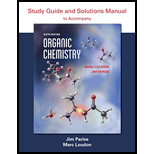
Organic Chemistry Study Guide and Solutions
6th Edition
ISBN: 9781936221868
Author: Marc Loudon, Jim Parise
Publisher: W. H. Freeman
expand_more
expand_more
format_list_bulleted
Question
Chapter 18, Problem 18.25P
Interpretation Introduction
Interpretation:
The equilibrium mixture of two completely different
Concept introduction:
Alkene metathesis reactions are the reactions in which two alkenes are broken at their double bonds and are rearranged to give the new alkene products. Grubb’s catalyst is used to catalyze the alkene metathesis reaction.
Expert Solution & Answer
Want to see the full answer?
Check out a sample textbook solution
Students have asked these similar questions
Answer
2. Provide a clear arrow-pushing mechanism for the following reactions. Do not skip proton
transfers, do not combine steps, and make sure your arrows are clear enough to be interpreted
without ambiguity.
a.
CH3
Ph
OEt
هد
Ph
CH3
Hint: the species on the left is an ynolate, which behaves a lot like an enolate.
b.
CH3
H3C
CH3
CH3
H3C
an unexpected product,
containing a single 9-
membered ring
the expected product,
containing two fused rings
H3C-I
(H3C)2CuLi
an enolate
Chapter 18 Solutions
Organic Chemistry Study Guide and Solutions
Ch. 18 - Prob. 18.1PCh. 18 - Prob. 18.2PCh. 18 - Prob. 18.3PCh. 18 - Prob. 18.4PCh. 18 - Prob. 18.5PCh. 18 - Prob. 18.6PCh. 18 - Prob. 18.7PCh. 18 - Prob. 18.8PCh. 18 - Prob. 18.9PCh. 18 - Prob. 18.10P
Ch. 18 - Prob. 18.11PCh. 18 - Prob. 18.12PCh. 18 - Prob. 18.13PCh. 18 - Prob. 18.14PCh. 18 - Prob. 18.15PCh. 18 - Prob. 18.16PCh. 18 - Prob. 18.17PCh. 18 - Prob. 18.18PCh. 18 - Prob. 18.19PCh. 18 - Prob. 18.20PCh. 18 - Prob. 18.21PCh. 18 - Prob. 18.22PCh. 18 - Prob. 18.23PCh. 18 - Prob. 18.24PCh. 18 - Prob. 18.25PCh. 18 - Prob. 18.26PCh. 18 - Prob. 18.27PCh. 18 - Prob. 18.28PCh. 18 - Prob. 18.29PCh. 18 - Prob. 18.30PCh. 18 - Prob. 18.31PCh. 18 - Prob. 18.32PCh. 18 - Prob. 18.33PCh. 18 - Prob. 18.34PCh. 18 - Prob. 18.35PCh. 18 - Prob. 18.36PCh. 18 - Prob. 18.37PCh. 18 - Prob. 18.38PCh. 18 - Prob. 18.39PCh. 18 - Prob. 18.40PCh. 18 - Prob. 18.41PCh. 18 - Prob. 18.42PCh. 18 - Prob. 18.43PCh. 18 - Prob. 18.44PCh. 18 - Prob. 18.45PCh. 18 - Prob. 18.46APCh. 18 - Prob. 18.47APCh. 18 - Prob. 18.48APCh. 18 - Prob. 18.49APCh. 18 - Prob. 18.50APCh. 18 - Prob. 18.51APCh. 18 - Prob. 18.52APCh. 18 - Prob. 18.53APCh. 18 - Prob. 18.54APCh. 18 - Prob. 18.55APCh. 18 - Prob. 18.56APCh. 18 - Prob. 18.57APCh. 18 - Prob. 18.58APCh. 18 - Prob. 18.59APCh. 18 - Prob. 18.60APCh. 18 - Prob. 18.61APCh. 18 - Prob. 18.62APCh. 18 - Prob. 18.63APCh. 18 - Prob. 18.64APCh. 18 - Prob. 18.65APCh. 18 - Prob. 18.66APCh. 18 - Prob. 18.67APCh. 18 - Prob. 18.68APCh. 18 - Prob. 18.69APCh. 18 - Prob. 18.70APCh. 18 - Prob. 18.71APCh. 18 - Prob. 18.72APCh. 18 - Prob. 18.73APCh. 18 - Prob. 18.74APCh. 18 - Prob. 18.75APCh. 18 - Prob. 18.76APCh. 18 - Prob. 18.77APCh. 18 - Prob. 18.78APCh. 18 - Prob. 18.79APCh. 18 - Prob. 18.80APCh. 18 - Prob. 18.81APCh. 18 - Prob. 18.82APCh. 18 - Prob. 18.83APCh. 18 - Prob. 18.84APCh. 18 - Prob. 18.85APCh. 18 - Prob. 18.86APCh. 18 - Prob. 18.87APCh. 18 - Prob. 18.88APCh. 18 - Prob. 18.89APCh. 18 - Prob. 18.90APCh. 18 - Prob. 18.91APCh. 18 - Prob. 18.92AP
Knowledge Booster
Similar questions
- b. H3C CH3 1. 2. H3O+ H3C MgBr H3Carrow_forwardPredict the major products of this reaction: excess H+ NaOH ? A Note that the first reactant is used in excess, that is, there is much more of the first reactant than the second. If there won't be any products, just check the box under the drawing area instead. Explanation Check Click and drag to start drawing a structure. © 2025 McGraw Hill LLC. All Rights Reserved. Terms of Use Privarrow_forward1. For each of the reaction "railroads" below, you are either asked to give the structure(s) of the starting material(s) or product(s), or provide reagents/conditions to accomplish the transformation, as indicated by the boxes. a. NaOMe H+ .CO,H HO₂C MeOH (excess) MeOH H3C Br يع CH3 1. LiAlH4 2. H3O+ 3. PBг3 H3C 1. Et-Li 2. H3O+ -CO₂Me -CO₂Me OH CH3 CH3 ল CH3arrow_forward
- Predict the intermediate 1 and final product 2 of this organic reaction: NaOMe ག1, ད།་, - + H You can draw 1 and 2 in any arrangement you like. 2 work up Note: if either 1 or 2 consists of a pair of enantiomers, just draw one structure using line bonds instead of 3D (dash and wedge) bonds at the chiral center. Explanation Check Click and drag to start drawing a structure. Х © 2025 McGraw Hill LLC. All Rights Reserved. Terms of Use | Parrow_forwardWhat is the total energy cost associated with the compound below adopting the shown conformation? CH3 HH DH CH3arrow_forwardΗΝ, Draw Final Product C cyclohexanone pH 4-5 Edit Enamine H3O+ CH3CH2Br THF, reflux H Edit Iminium Ionarrow_forward
- How many hydrogen atoms are connected to the indicated carbon atom?arrow_forwardIdentify the compound with the longest carbon - nitrogen bond. O CH3CH2CH=NH O CH3CH2NH2 CH3CH2C=N CH3CH=NCH 3 The length of all the carbon-nitrogen bonds are the samearrow_forwardIdentify any polar covalent bonds in epichlorohydrin with S+ and 8- symbols in the appropriate locations. Choose the correct answer below. Η H's+ 6Η Η Η Η Η Ηδ Η Ο Ο HH +Η Η +Η Η Η -8+ CIarrow_forward
- H H:O::::H H H HH H::O:D:D:H HH HH H:O:D:D:H .. HH H:O:D:D:H H H Select the correct Lewis dot structure for the following compound: CH3CH2OHarrow_forwardRank the following compounds in order of decreasing boiling point. ннннн -С-С-Н . н-с- ННННН H ΗΤΗ НННН TTTĪ н-с-с-с-с-о-н НННН НН C' Н н-с-с-с-с-н НН || Ш НННН H-C-C-C-C-N-H ННННН IVarrow_forwardRank the following compounds in order of decreasing dipole moment. |>||>||| ||>|||>| |>|||>|| |||>||>| O ||>>||| H F H F H c=c || H c=c F F IIIarrow_forward
arrow_back_ios
SEE MORE QUESTIONS
arrow_forward_ios
Recommended textbooks for you
